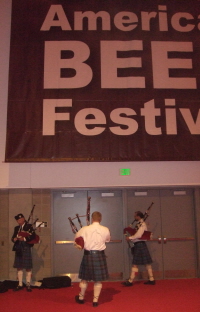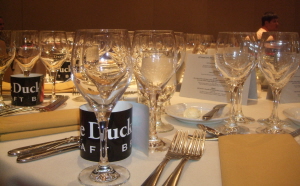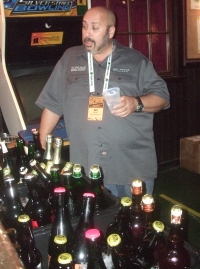As a veteran of the Great British Beer Festival (GBBF) visiting the Great American Beer Festival (GABF) for the first time, you’re inevitably drawn to make comparisons. And the one that comes spontaneously to my mind is that the GABF is, well, sexier. Although the GBBF is starting to shift a bit in terms of demographics, at GABF there’s a younger, trendier feel. It’s still predominantly a male crowd — my impression was that the British event is doing rather better in terms of gender balance — but there are notably less beards, beer bellies and decaying T-shirts and notably more strapping crop-haired and heavily tattooed twentysomethings in combat shorts. And though some of my dearest friends have beards and beer bellies, I confess the latter group are easier on the eye.
Curiously, women seem better represented among the ranks of orange T-shirted, Samuel Adams-sponsored Brewers Association volunteers. They, too, are a notably youthful bunch. And before I find myself up on charges of ageism, I should add that it’s not just the age but the buzz — the exhilirating feeling that the event is part of something cuttting edge and brimming with energy. It’s not that the GBBF doesn’t buzz in its way, but it could do with an injection of GABF-style adrenalin.
Such comparisons are apt as the American festival is historically the daughter of the British one. As is well known, GABF founder and US home brewing guru Charlie Papazian got the idea while visiting GBBF in the company of the great Michael Jackson. A much quoted but possibly apocryphal account of their conversation has Charlie saying they should do something like this in the States and Michael replying, in his dry Yorkshire way, “Good idea, Charlie. But what would you do for the beer?” A photo of Michael in his twinkling prime, leaning on a globe with beer glass in hand, now hangs over the extensive bars in the Denver Convention Center, like a beneficient founding father. He’d no doubt take great pride in what they’ve done for the beer since then.
At the 29th GABF, the beers came in over 2,000 varieties from over 460 breweries, and that’s still not even a third of the total breweries now operating in the United States. According to the latest Brewers Association figures, there are 1,640 working breweries, of which almost 1,000 are brewpubs and a mere 20 are big industrial plants. As in Britain, while the overall beer market is shrinking, exacerbated by the recession, sales of craft beer are expanding. The dollar value was up last year by over 10% from 2008, and early figures for this year show the upward trend persisting. But craft beer is still a small fish in a very large pond of yellow rice-based fizz, accounting for only $7billion of the US total of $101billion of beer sales in 2009.
With their native brewing tradition obliterated by Prohibition and the subsequent rise of the megabrewers, American craft brewers started from a clean slate, and the original tendency to clone Old World styles has long since passed into history. US versions of India Pale Ales, laden with the oily bitter grapefruit and pineapple kick of Cascade hops, have become the signature products of the craft brewing movement, and they’re still the biggest sector of the market. But there’s much, much more. Stouts, porters and even pilsners are likely to have their hopping rates and gravities cranked up to 11. Beers of all styles are regularly dosed with wild yeasts and aged in Bourbon barrels and/or flavoured with anything from cocoa pods, chilli and coconut to spruce tips and white sage.
GABF also includes a beer competition, which is more integral to the event than Champion Beer of Britain is to GBBF, and occupies several days of judging time. The competition is style-obsessed to say the least, and to accomodate the burgeoning imagination of brewers there are now 79 recognised style categories, from American-style India Pale Ale to Wood-and-Barrel-Aged Strong Stout. Pity the poor judges who receive a thick volume of definitions before starting work. The home brewing heritage, so important in a country where opportunities to develop the craft professionally were once very limited, is reflected in a Pro-Am strand where home brewers team with commercial brewers to enter newly created beers.
The Convention Center, with its landmark sculpure of a giant blue bear peering through the plate glass, is a vast space, the bigggest indoor venue in the state, bigger than the GBBF’s Earls Court but considerably less crowded. Even so, the atmosphere is hectic. Queues, or ‘lines’ in the local parlance, rapidly form for certain breweries. They also form for the toilets, or ‘rest rooms’ if you prefer the delightful American euphemism, and it’s indicative of that gender imbalance I mentioned earlier that this is the only big event I’ve ever attended where the girls stroll straight in while the blokes line up uncomfortably.
As at GBBF, raucous football crowd roars sweep in waves across the space whenever anyone drops a glass, with somewhat less justification as the “glasses” are made of tough plastic. And as at GBBF there’s a weird thing about daft headgear which runs to foam hats made to resemble hop cones as well as the more usual comedy Viking helmets and beer glasses. Necklaces of empty beer cans and pretzels are other ill-advised fashion accessories.
The format of the festival is rather different, however. Admission to a four hour session is a steep $55, but all the beer is free, so long as you consume it in tiny one ounce servings — 30ml or two tablespoons. In my view that’s too small to appreciate fully both palate and finish. Of course, lines permitting, you can always go back for another pour. Notices on the bars insist pours are accurate, and some servers clearly take pride in being dead on the line, but others, particularly brewers, are more generous. Numbers are strictly limited and in recent years the event has been selling out — this year a record five weeks in advance. I understand the Brewers Association are considering expanding into additional space within the Convention Center.
My press badge got me into all sessions for free, but had I paid, I think I’d have found it a frustrating experience in some ways, making you feel you need to get your money’s worth by working round as many tiny tastes as possible within a limited time. And such small quantities don’t lend themselves to getting a beer and taking it away somewhere to sample at leisure: instead they encourage constant circulation around the bars.
Still there are some very positive and responsible aspects to the way the event is delivered. Designated Drivers get in at a hefty discount, and are treated to free artisanal soft drinks and a massage in their own reserved area. GBBF could learn from the plentiful water stations, where water coolers provide not only drinking water but also the opportunity to rinse your glass.
Like many such events, GABF is catalysing its own fringe festival, with both formal and informal events, often organised by third parties, taking place beside the main one. This is particularly fitting in a city that likes to bill itself as the ‘Napa Valley of beer’, where the Mayor and Democrat candidate for state governer John Hickenlooper is himself the founder of the local Wynkoop brewpub. The various side events in bars and other venues are now being marketed by beer enthusiast and tourism professional Rich Grant of Visit Denver as the Denver Beer Fest.
My press badge got me into a couple of events featuring beer and food pairing. In the Farm to Table Pavilion at the back of the main Convention Center hall, the Culinary School of the Rockies matched chefs with brewers to showcase local ingredients and some truly stunning beers. And the media lunch at the Marriott City Center hotel matched an impressive four courses with beers that were very much fit for table. Following this the press pack — from national newspapers to beer bloggers — were whisked on a coach tour that included the veteran Breckenridge Brewery and Stranahan’s distillery next to the Rackhouse specialist beer pub. I’d love to write about the the smooth, clean, sweetly malty and inexplicably sherryish Colorado whiskey made from 100% Rocky Mountain malt by irrepressible brewer-turned-distiller Jake Norris, but it’s strictly speaking off topic.
We ended up at Wynkoop in the city’s LoDo (Lower Downtown) district for the annual charity fundraising rare beer tasting, this year billed as Pints for Prostates. Most of the beers had gone by then, but it was good to drink what was left in measures bigger than two tablespoons, and in the very pleasant and interesting company of New York City beer and pub videocasters the Happy Hour Guys.
On the Saturday I decided to forego my free admission in favour of drinking proper measures in proper pubs, but found myself at Denver’s leading specialist beer pub, the Falling Rock, just as another special event was getting into gear. For several years now, military medic turned beer expert and all-round character “Doctor” Bill Sysak, now a beer consultant for California brewer Stone’s flagship pub-restaurant, has run a rare beer tasting during GABF week featuring selections from his own 2,000-strong cellar alongside rare beers brought along by participants. For $30 per person, Bill was offering tastes of over 100 rare beers, and I couldn’t refuse.
Fellow beer writer Patrick, editor of the Albuquerque Beer Scene blog based in New Mexico, heroically took notes on everything, but I abandoned myself to the fireworks display of flavour from Bill’s pours, which included imported delights such as Achel Extra 9.5 Bruin and a limited edition Dupont saison alongside American beer geek pleasers like Lost Abbey Angel’s Share, New Belgium La Folie and a barrel aged version of Ten Fiddy from local heroes Oskar Blues. If anyone still doubts beer can offer a greater spectrum of flavours than wine, I’d recommend a few choice bottles from Dr Bill’s cellar.
Denver wasn’t on my must visit list and I came here only because of the event. But I was pleasantly surprised to discover a fascinating city in its own right. It stands “mile high” at 1600m above sea level on the last westward stretch of the Great Plains, in the shadow of the Front Range of the Rocky mountains. Historically, it’s a frontier town with a history embedded in the less than honorable European colonisation of the North American West. The Colorado Soldier’s Monument just below the Mile High markers on the steps of the State Capitol is scarred by attempts to erase the name ‘Sand Creek’ from its inscribed list of battles — in truth this 1864 “battle” was a massacre of peaceful Cheyenne and Arapaho, mainly women and children.
Something like a natural environment has been restored in the chain of parks that surround the confluence of the South Platte river and Cherry Creek, at the point of the original European settlement. The area is now the focus of a delightful network of off-road walking and cycling trails that, alongside a compact size, good public transport and a cycle hire scheme on the Paris/London model, makes this an easy city to explore without a car.
You can just about get an idea of how it once looked to both Native American and European travellers coming upon these little rivers threaded through the arid plains, and shivering in the looming shadow of the Rockies, their jagged red and purple peaks a wall across the world. The locals shook their heads to see the crazy whites building permanent homes on the riverside, and sure enough the floods came down from the mountains and swept the first town away. Denver today seems rather better prepared for the annual flood of craft beer and the people that drink it.
Beer picks
- Boulevard Saison Brett Kansas City, Missouri
- Cigar City Humidor Series India Pale Ale Tampa, Florida
- Foothills Sexual Chocolate Imperial Stout 2009 Winston-Salem, North Carolina
- Maui CoCoNut PorTeR Lahaina, Hawaii
- SweetWater Dank Tank Magnum IP Atlanta, Georgia
- Tröegs Troegenator Doublebock Beer Harrisburg, Pennsylvania
Great American Beer Festival website: http://www.greatamericanbeerfestival.com
Denver Beer Fest: http://www.denver.org/denverbeerfest












Nice post des, send a copy to gbbf organisers!
So long as they don’t start serving in 1oz measures!
Crop-haired and heavily tattooed twentysomethings in combat shorts are easy on the eye? Really?